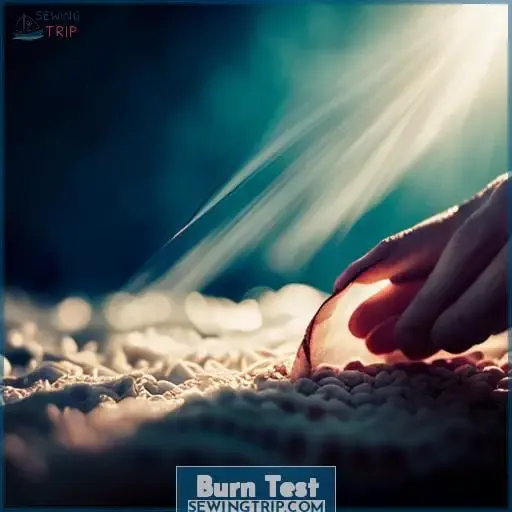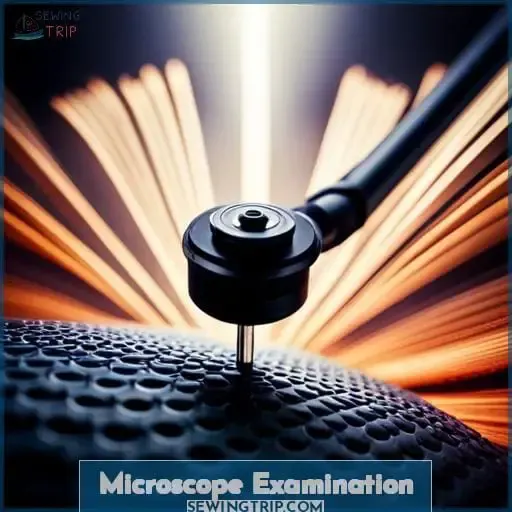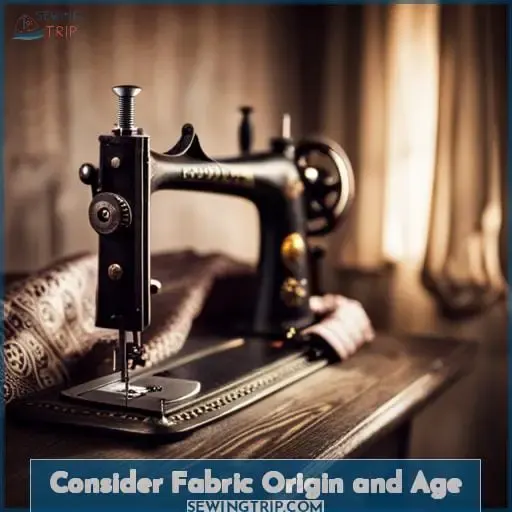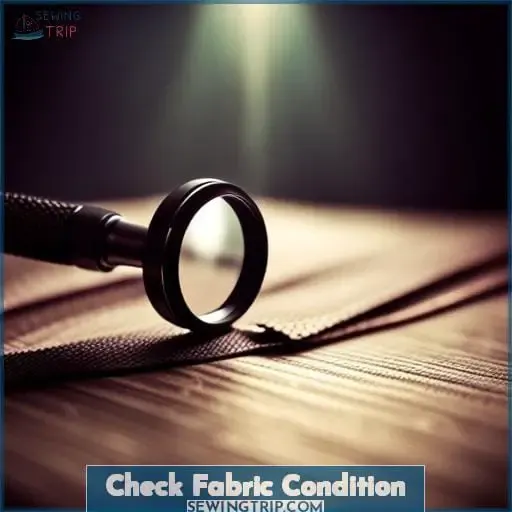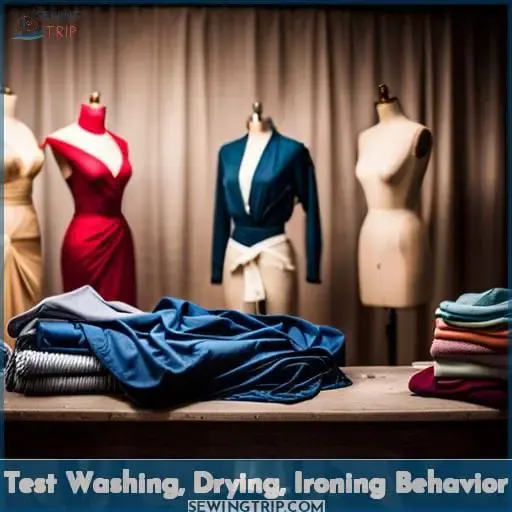This site is supported by our readers. We may earn a commission, at no cost to you, if you purchase through links.
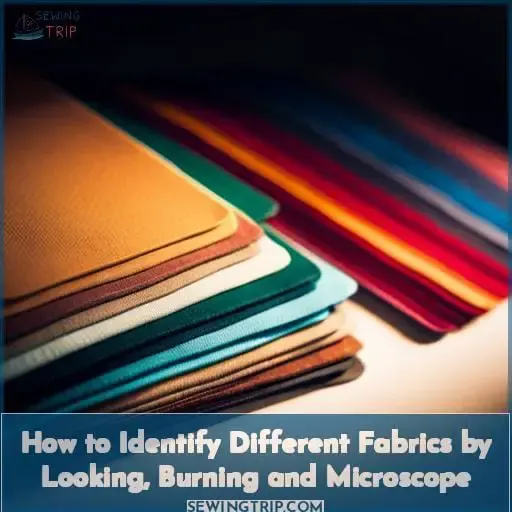 You’re faced with a mystery fabric that needs identifying. Before you rush to burn or microscope test it, start by looking closely first. Note the weight, drape, texture and any distinguishing visual characteristics. Feel the hand of the fabric between your fingers and consider how it compares to known fabrics like cotton, silk or wool.
You’re faced with a mystery fabric that needs identifying. Before you rush to burn or microscope test it, start by looking closely first. Note the weight, drape, texture and any distinguishing visual characteristics. Feel the hand of the fabric between your fingers and consider how it compares to known fabrics like cotton, silk or wool.
Make an educated guess as to fiber content just from this visual inspection. If still stumped, then reach for your lighter.
By burning a small swatch, how quickly it ignites and self-extinguishes, the smell, and ash left behind will all reveal its fiber identity. With practice, you’ll hone your skills at accurately identifying fabrics by sight, touch and burn test.
The microscope can provide confirmation, but a simple burn test is often sufficient.
Table Of Contents
Key Takeaways
- Perform an initial visual inspection of the fabric’s weight, drape, texture, and look for clues about knit or woven structure.
- Do a burn test to analyze the speed of ignition, smell, and ash residue as clues to natural or manufactured fibers.
- Use a microscope for magnified examination of weave patterns, yarn details, and fabric texture.
- Evaluate fabric characteristics like flaws, elasticity, damage, and laundering behavior for additional identification clues.
Visual Inspection
You were sure the fuchsia polyester pants from the ’80s would make a fabulous blouse, but after a magnified peek under the microscope, it was obviously upholstery-grade velour.
Careful scrutiny of fabric textures, color clues, age indicators, stain analysis, and pattern recognition aids in fabric identification and distinguishing fabric types. Visual inspection of fabric characteristics and properties provides objective data points for accurate conclusions.
Placing the mystery fabric sample under a microscope allows magnified examination and comparison to known reference images for definitive identification. Matching weave patterns, yarn features, density, surface texture and other traits narrows down the fabric’s true identity.
A trained eye and structured approach systematically inspects fabrics to reach accurate conclusions.
Burn Test
To reliably determine fiber content, perform a small burn test. Natural fibers like cotton and linen burn quickly with a yellow flame, continue burning, and leave soft gray ash. Manufactured fibers such as polyester and acrylic burn slower, melt, emit distinct smells, and leave hard black or brown beads behind.
Natural Fibers
We can examine natural fibers by watching how quickly they burn and smelling the smoke when we test them. Cotton burns fast with a yellow flame, continuing to burn with smoke that smells like leaves. Wool and silk char slowly, self-extinguish, and give off a burning hair or feather smell.
Linen also burns fast with a yellow flame but smells like paper. Observing burn speed, flame color, smoke scent, and ash helps identify natural fiber textiles. Clothing materials like wool, cotton, linen, and silk have distinct burn test properties useful for material identification.
Manufactured Fibers
Polyester: Burns slowly, melts with black smoke, self-extinguishes, smells sweet or fruity, leaves hard black and brown beads. Acrylic: Burns, melts, sputters, continues burning, smells acidic, leaves hard black crust.
Nylon: Burns slowly, melts, self-extinguishes, smells like celery, leaves hard grey beads.
Rayon burns quickly like cotton. Identify fabrics with resource guides and tests.
Microscope Examination
Hold the mystery fabric snug under the microscope lens for magnified examination and compare to reference images for possible identification. With the precision of a fabric detective, scrutinize the textile: heed fiber details, weave patterns, texture intricacies.
Trace yarns under the microscope lens, inspecting their size, shape, twist. Note the number of yarns per inch of fabric: warp, weft, and pick count. Search for fabric flaws – snags, slubs, knots, thin spots. Does the fabric display characteristics of natural fibers like cotton, silk, wool or linen? Or does it appear to be manufactured fiber like nylon, polyester, acrylic, acetate or rayon? Meticulous microscope analysis provides keen insights.
Match observations to images in your fabric guide for informed conclusions about the mystery material at hand.
Consider Fabric Origin and Age
You can gain insights into a fabric’s identity by considering its origin and age. Test the fabric’s burning behavior and use a microscope to inspect it at a magnified level.
Test Fabric Burn Behavior
Burn a tiny swatch of the fabric to instantly reveal its fiber content by observing the flame color, melting behavior, aroma, smoke, and ash residue.
- Cotton burns quickly with a yellow flame, smells like burning leaves, and leaves a soft gray ash.
- Silk burns slowly, emits an aroma like burning hair, and leaves behind black beads of ash.
- Wool also burns slowly, giving off a smell similar to burning hair or feathers, and leaves brittle black ash.
- Acetate burns slowly as well, smelling like vinegar, and leaves hard black beads of ash.
- Polyester burns slowly with black smoke, has a sweet or fruity smell, and leaves hard black or brown beads.
– Microscope Fabric Inspection
The microscope exposes the inner secrets of the mystery fabric’s weave. Magnified fibers reveal their identity, ready for objective comparison to reference images. Meticulous inspection under the lens can validate suspicions raised through initial visual and tactile analysis.
With patience, the unknown relinquishes its secrets under focused, scientific, microscopic examination.
– Online Fabric Identification Guide
Access The Fabric Resource’s extensive online guides for fantastically quick and easy fabric identification, my friend!
- Search fabrics by fiber – wool, silk, cotton, linen
- Explore fabric types – silk and silk-like textiles
- Access identification tips and techniques
- Compare fabric images and descriptions
- Email the site for personalized help
Scientific analysis and matching unknown fabrics to online guides enables you to master fabric identification with ease. Identifying fabrics by appearance, feel, fiber content and burn test behavior allows for correct labeling for sewing success.
Check Fabric Condition
Inspect the fabric’s elasticity by gently pulling on it to get clues about its identity. Over time, elasticity loss can indicate the fabric’s age and type. Closely check for breaks, holes, thinning, fading, discoloration, and fraying that may provide identification clues.
Assess damage like rips, tears, mold, and mildew that imply poor preservation, storage conditions, or aging.
Scan all sides, the inside and seams for signs of insect or rodent infestation. Notice if the fabric stretches and springs back readily or has become brittle. Evaluate its elasticity through gentle tugging to help determine if it’s a natural or synthetic fiber.
With a meticulous inspection and shrewd detection, the fabric’s telltale signs can unlock its identity.
Test Washing, Drying, Ironing Behavior
Wondering how something behaves in the wash, dryer, and when ironed can provide clues for identifying a mystery fabric, can’t it? Laundering experiments on fabric samples reveal reactions that indicate fiber content and composition.
Observing a swatch during prewash, machine washing, tumble drying, and ironing stages provides fabric characteristics. Look for shrinking, stretching, wrinkling, colorfastness, pilling, fraying and other fabric behaviors.
Natural fabrics like cotton and linen can shrink or wrinkle, while synthetics may resist heat settings. A microscope isn’t needed to notice if a textile pills or resists stains. Record performance during testing stages and match findings to typical material reactions described in fabric guides.
Knowledge of how a mystery cloth handles laundering offers clues to its identity.
Conclusion
Identifying fabrics can often feel like detective work, but don’t get discouraged. With a few techniques up your sleeve, you can become a textile sleuth in no time. Though visual inspection and burner testing present challenges, using a microscope offers a new perspective.
Examining fabrics under magnification and comparing them to reference images can unlock mysteries. Let the hunt for how to identify fabrics begin by gathering your tools, honing your senses, and developing an eye for detail.
With knowledge and practice, even anonymity will not protect a fabric’s identity for long.


